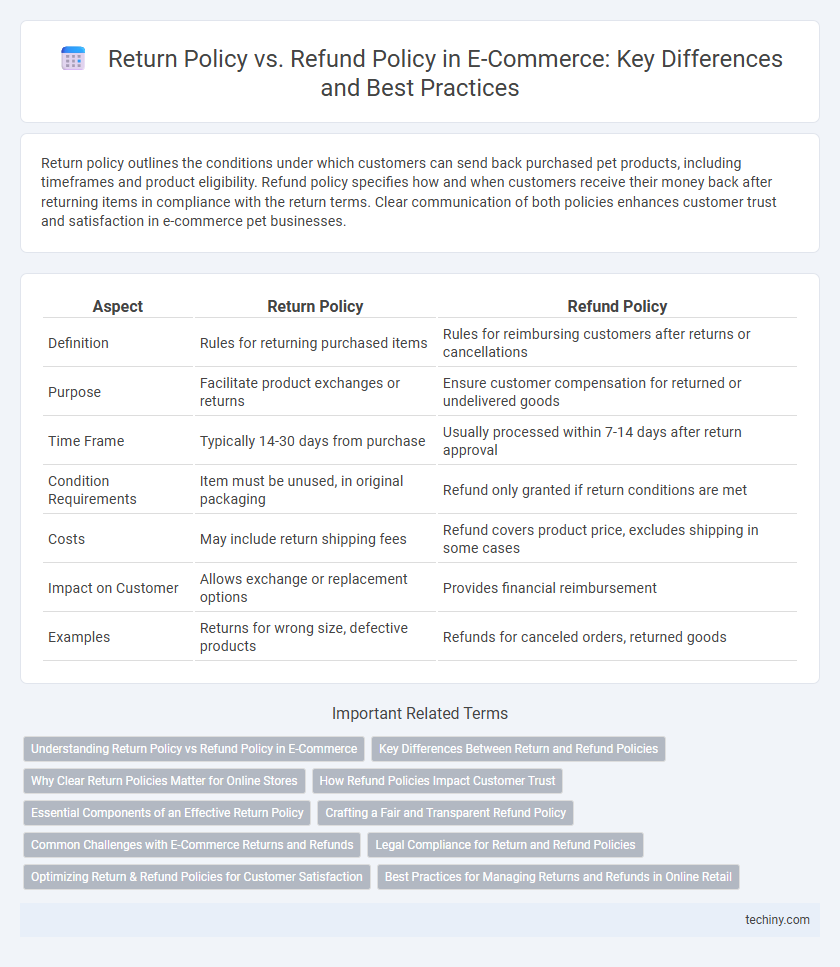Return policy outlines the conditions under which customers can send back purchased pet products, including timeframes and product eligibility. Refund policy specifies how and when customers receive their money back after returning items in compliance with the return terms. Clear communication of both policies enhances customer trust and satisfaction in e-commerce pet businesses.
Table of Comparison
| Aspect | Return Policy | Refund Policy |
|---|---|---|
| Definition | Rules for returning purchased items | Rules for reimbursing customers after returns or cancellations |
| Purpose | Facilitate product exchanges or returns | Ensure customer compensation for returned or undelivered goods |
| Time Frame | Typically 14-30 days from purchase | Usually processed within 7-14 days after return approval |
| Condition Requirements | Item must be unused, in original packaging | Refund only granted if return conditions are met |
| Costs | May include return shipping fees | Refund covers product price, excludes shipping in some cases |
| Impact on Customer | Allows exchange or replacement options | Provides financial reimbursement |
| Examples | Returns for wrong size, defective products | Refunds for canceled orders, returned goods |
Understanding Return Policy vs Refund Policy in E-Commerce
Return policy in e-commerce defines the conditions and time frame under which customers can send back products, while refund policy specifies the procedures and criteria for reimbursing payments after returns. A clear return policy outlines acceptable product conditions for returns, shipping responsibilities, and deadlines, ensuring transparency and reducing disputes. Refund policies detail how refunds are processed, including full or partial amounts, processing times, and payment methods, directly impacting customer satisfaction and trust.
Key Differences Between Return and Refund Policies
Return policies define the conditions under which customers can send products back, including time limits, product condition, and restocking fees. Refund policies specify the process and timing for reimbursing customers, detailing whether refunds are full, partial, or store credit. Understanding these distinctions helps e-commerce businesses manage customer expectations and streamline dispute resolution efficiently.
Why Clear Return Policies Matter for Online Stores
Clear return policies reduce customer hesitation by providing transparent guidelines on returning products, which enhances trust and increases conversion rates. They minimize disputes and streamline the return process, saving time and operational costs for e-commerce businesses. Well-defined return policies contribute to higher customer satisfaction and repeat purchases, driving long-term revenue growth.
How Refund Policies Impact Customer Trust
Refund policies significantly influence customer trust by providing clear guidelines on how returns translate into monetary compensation or store credit, reducing purchase hesitation. Transparent and fair refund procedures help build confidence that the business values customer satisfaction and will address issues promptly. E-commerce companies with lenient and well-communicated refund policies often experience higher customer loyalty and lower cart abandonment rates.
Essential Components of an Effective Return Policy
An effective return policy in e-commerce clearly defines the time frame for returns, acceptable product conditions, and required documentation such as receipts or order numbers. It specifies whether return shipping costs are covered by the seller or buyer and outlines the process for initiating a return, including authorization steps. Transparent communication of these components enhances customer trust and reduces disputes, directly impacting customer satisfaction and repeat business rates.
Crafting a Fair and Transparent Refund Policy
Crafting a fair and transparent refund policy is essential for building customer trust and reducing disputes in e-commerce. Clear guidelines on eligibility, timeframes, and required documentation help streamline the refund process and improve customer satisfaction. Emphasizing transparency in refund conditions differentiates the policy from the broader return policy, ensuring customers understand their rights and obligations effectively.
Common Challenges with E-Commerce Returns and Refunds
E-commerce businesses often face challenges such as delayed processing times, unclear return instructions, and discrepancies between return policies and actual refund practices. Customers frequently encounter confusion over eligibility periods, product condition requirements, and the distinction between store credit versus full monetary refunds. Streamlining communication and automating return tracking can mitigate these common issues and improve overall customer satisfaction.
Legal Compliance for Return and Refund Policies
Return and refund policies must comply with consumer protection laws such as the Consumer Rights Act 2015 in the UK or the Federal Trade Commission regulations in the US, ensuring transparent terms for returns, exchanges, and refunds. E-commerce businesses are legally required to provide clear instructions on return timeframes, conditions for product eligibility, and refund processing periods to avoid disputes and potential penalties. Non-compliance can result in legal action, fines, and damage to brand reputation, emphasizing the importance of aligning policies with regional regulations.
Optimizing Return & Refund Policies for Customer Satisfaction
Optimizing return and refund policies in e-commerce enhances customer satisfaction by clearly defining time frames, conditions, and processes for returns and refunds. Transparent policies reduce customer uncertainty and build trust, leading to increased repeat purchases and positive reviews. Leveraging data analytics to refine policy terms based on customer behavior and feedback drives continuous improvement in policy effectiveness.
Best Practices for Managing Returns and Refunds in Online Retail
Clear return policies specifying timeframes, conditions, and item eligibility reduce customer confusion and disputes in online retail. Offering hassle-free refund processes with multiple payment options enhances customer trust and satisfaction. Leveraging automated return management systems improves efficiency, minimizes errors, and accelerates refund processing times.
Return Policy vs Refund Policy Infographic

 techiny.com
techiny.com